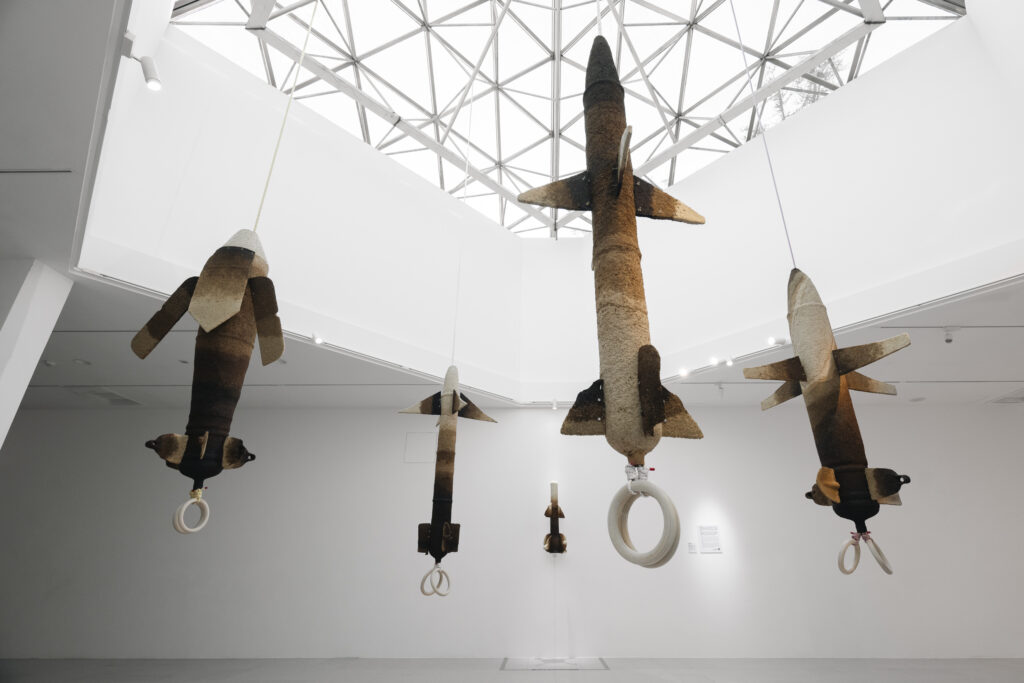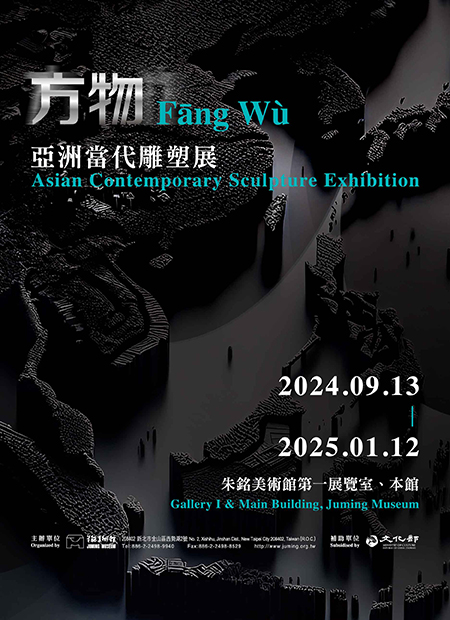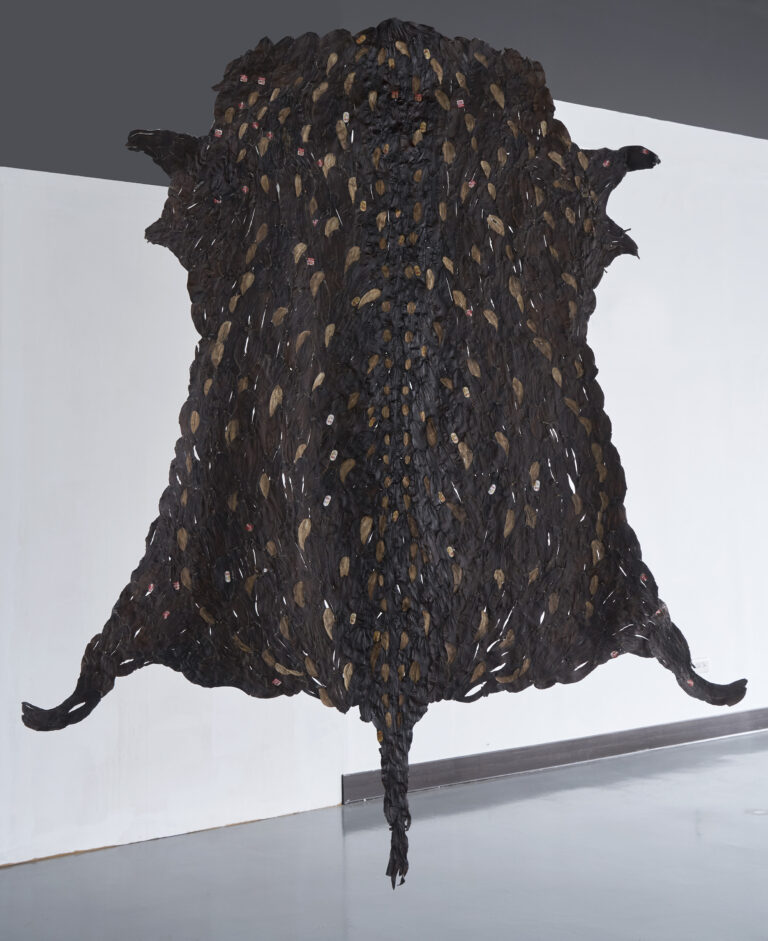
“Bagasse Missiles” a part of “Fāng Wù — Asian Contemporary Sculpture Exhibition” at Tainan Art Museum
Taiwan, situated in the subtropical region, once had sugarcane as its primary export commodity. Lo Yi-Chun ingeniously employs bagasse to create a series of interactive missiles: as viewers grip the handle and open and close their arms in a chest exercise motion, the suspended missiles are released and fall back down. This clever juxtaposition of weapon and exercise equipment echoes how sugar, once a coveted tropical resource that provoked wars and colonisation, has now become a calorie source that people eagerly try to burn off through exercise.
This work not only reveals the influence and energy conversion of materials but also highlights the power dynamics behind cash crops and the contradictions and conflicts inherent in contemporary geopolitics. The various models of these sugarcane pulp missiles trace the evolving role of the sugar industry in producing ‘agricultural products – daily necessities – military fuel (ethanol/butanol)’. Additionally, it responds to the absurd political tensions in today’s tumultuous international arena, where missiles frequently traverse national borders.
Fāng Wù — Asian Contemporary Sculpture Exhibition
Organised by the Juming Museum, the Asian Contemporary Sculpture Exhibition “方物/Fāng Wù” focuses on the concept of “matter” and explores the different meanings of “material” from the past, as well as the latent revelations and new perspectives they may offer. This exhibition features 20 artists from across Asia, including Japan, South Korea, Thailand, Indonesia, China, Hong Kong, and Taiwan.
The exhibition’s emphasis on matter originates from fundamental inquiries into the relationships between Earth and humanity, the world and existence, and nature and art. It encourages a re-examination of matter, not merely viewing it as a medium, material, or object used to express human ideas and intentions, but as an autonomous entity with its own agency. This thinking responds to New Materialism, a material theory developed from the critique of anthropocentrism in the Anthropocene discourse. However, the exhibition does not aim to discuss or validate New Materialism theories. Instead, it seeks to deconstruct the hierarchical dominance and subordinate logic between humans and matters by re-examining their complex relationships. Through this perspective, the exhibition aims to highlight the inherent relativity of all existences and to explore a redefinition of the identity of Asian contemporary sculpture.
Consequently, this exhibition places special emphasis on “locality.” The division and opposition between the central/core and the local/periphery can be seen as products of human politics and the desire for dominance. Reflecting on anthropocentrism and the modern capitalist civilisation that has developed alongside it, the contemplation, exploration, representation, and practice of “locality” hold unique significance and value. They resist or even transcend this binary framework, inviting further thought on the potential interactions and the symbiotic “translocal” relationships within the entire ecosystem. The exhibition is thus aptly titled “方物/Fāng Wù,” where “方/Fāng” in Chinese refers to locality and “物/Wù” to matters.
The Chinese term “方物/Fāng Wù,” originating from ancient texts, initially referred to local products and carried connotations of description and identification. Drawing from this concept, the exhibition explores new perspectives on matter from a “local” standpoint, grounded in the principle of decentralisation. By critically examining and acknowledging the role and impact of matter, and by respecting the existence of all things, including the non-human world, the exhibition rejects a singular logic and embraces diversity. This approach to matter provides a necessary foundation and support for understanding and perceiving “locality.” Conversely, the heterogeneity and diversity, complexity and dynamism of “locality” open up multiple pathways for the in-depth exploration of matter.
In summary, “Fāng Wù” reaffirms the active role of matter from a non-anthropocentric standpoint. It explores the in-depth meanings and dynamism of matter through contemporary art experiments, reconnecting human and non-human worlds as well as material and non-material realms.
Additionally, “Fāng Wù” highlights both the unique “locality” of Taiwan and Asia and the significance of “trans-locality”. In the context of contemporary art’s internationalisation, the exhibition revisits regional specificity, offering distinct interpretations, explorations, and imaginings of detected similarities and differences. It connects diverse regions, fostering cross-regional interactions and reflections.
“Fāng Wù” also, in a reflexive manner, directly points to Asian/local sculptures that use materials as a medium, re-examining and offering multiple interpretations of locality. It explores how these “local objects” can offer new perspectives on understanding the world, drawing insights from nature and the environment while showcasing their diversity and complexity. Ultimately, “Fāng Wù” engages in reshaping matter epistemology for a new era, potentially, and fundamentally, calling for a perspective that transcends materiality itself.
Curator|CHOI Tae Man、LIU Chu Lan
Artists|CHAN Shin-Tai、CHEN Shu-Yen、Heri DONO、FU Zhong Wang、FX HARSONO、KIM Dabal、KIM Yujung、KISHI Kaoru、LEE James Ming-Hsueh、LIU Po-Chun、LO Yi-Chun、OHMAKI Shinji、SHIN Meekyoung、SO Wing-Po、SUNG Dong-Hun、TORIMITSU Momoyo、YANG Wei-Lin、Yeesookyung、Pannaphan YODMANEE、YUON Kibaik.*in alphabetical order.
Subsidised|Ministry of Culture Republic of China(R.O.C.)
Venue: Tainan Art Museum
From March 28, 2024 till June 16, 2024
For more information: https://www.juming.org.tw/mainssl/modules/MySpace/BlogInfo.php?xmlid=336931



